2019 KIA FORTE wheel
[x] Cancel search: wheelPage 475 of 550
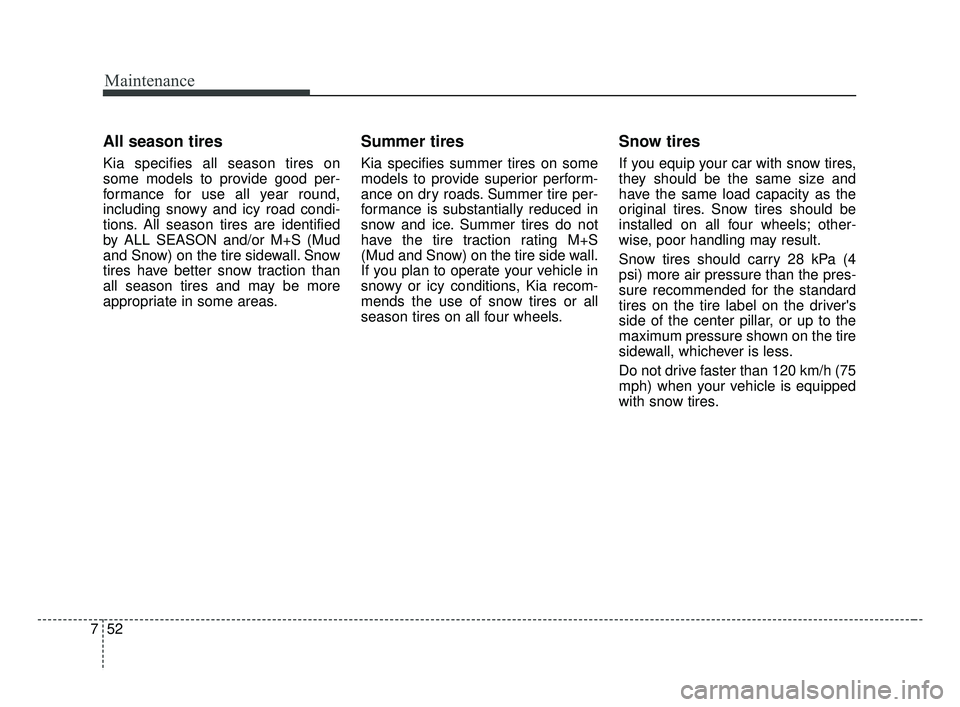
Maintenance
52
7
All season tires
Kia specifies all season tires on
some models to provide good per-
formance for use all year round,
including snowy and icy road condi-
tions. All season tires are identified
by ALL SEASON and/or M+S (Mud
and Snow) on the tire sidewall. Snow
tires have better snow traction than
all season tires and may be more
appropriate in some areas.
Summer tires
Kia specifies summer tires on some
models to provide superior perform-
ance on dry roads. Summer tire per-
formance is substantially reduced in
snow and ice. Summer tires do not
have the tire traction rating M+S
(Mud and Snow) on the tire side wall.
If you plan to operate your vehicle in
snowy or icy conditions, Kia recom-
mends the use of snow tires or all
season tires on all four wheels.
Snow tires
If you equip your car with snow tires,
they should be the same size and
have the same load capacity as the
original tires. Snow tires should be
installed on all four wheels; other-
wise, poor handling may result.
Snow tires should carry 28 kPa (4
psi) more air pressure than the pres-
sure recommended for the standard
tires on the tire label on the driver's
side of the center pillar, or up to the
maximum pressure shown on the tire
sidewall, whichever is less.
Do not drive faster than 120 km/h (75
mph) when your vehicle is equipped
with snow tires.
BDm CAN (ENG) 7.qxp 7/4/2018 10:25 AM Page 52
Page 477 of 550
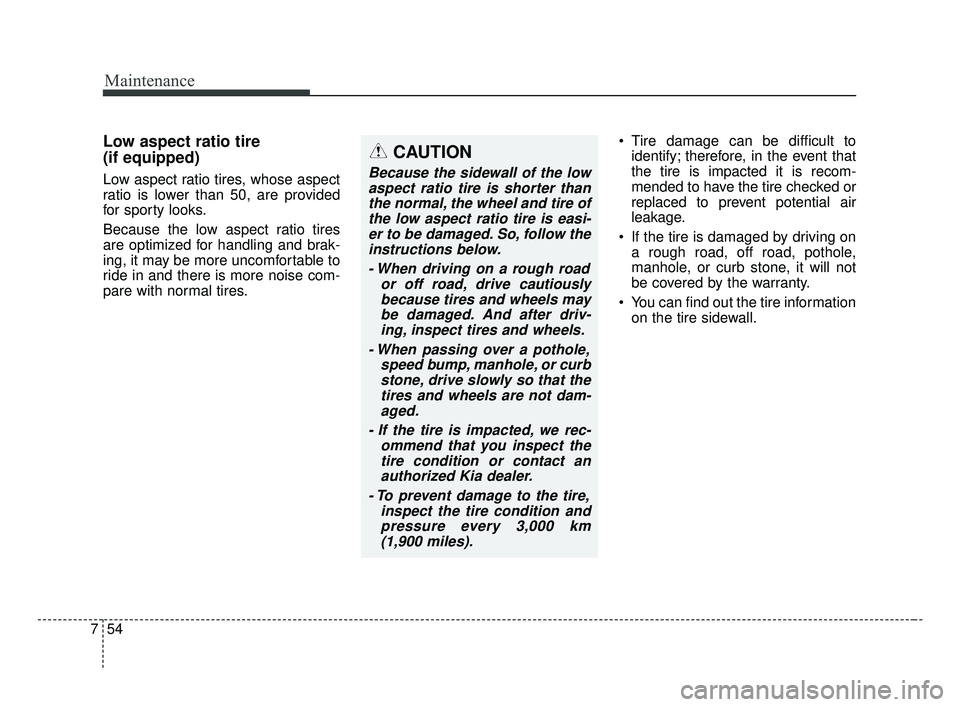
Maintenance
54
7
Low aspect ratio tire
(if equipped)
Low aspect ratio tires, whose aspect
ratio is lower than 50, are provided
for sporty looks.
Because the low aspect ratio tires
are optimized for handling and brak-
ing, it may be more uncomfortable to
ride in and there is more noise com-
pare with normal tires. Tire damage can be difficult to
identify; therefore, in the event that
the tire is impacted it is recom-
mended to have the tire checked or
replaced to prevent potential air
leakage.
If the tire is damaged by driving on a rough road, off road, pothole,
manhole, or curb stone, it will not
be covered by the warranty.
You can find out the tire information on the tire sidewall.
CAUTION
Because the sidewall of the lowaspect ratio tire is shorter thanthe normal, the wheel and tire ofthe low aspect ratio tire is easi-er to be damaged. So, follow theinstructions below.
- When driving on a rough road or off road, drive cautiouslybecause tires and wheels maybe damaged. And after driv-ing, inspect tires and wheels.
- When passing over a pothole, speed bump, manhole, or curbstone, drive slowly so that thetires and wheels are not dam-aged.
- If the tire is impacted, we rec- ommend that you inspect thetire condition or contact anauthorized Kia dealer.
- To prevent damage to the tire, inspect the tire condition andpressure every 3,000 km(1,900 miles).
BDm CAN (ENG) 7.qxp 7/4/2018 10:25 AM Page 54
Page 517 of 550
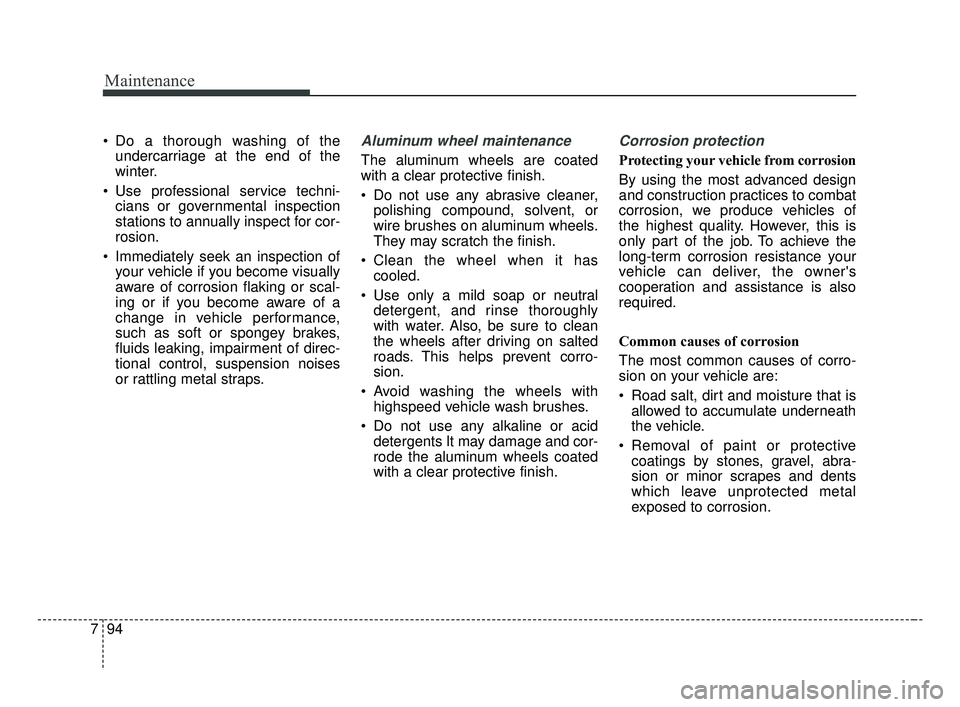
Maintenance
94
7
Do a thorough washing of the
undercarriage at the end of the
winter.
Use professional service techni- cians or governmental inspection
stations to annually inspect for cor-
rosion.
Immediately seek an inspection of your vehicle if you become visually
aware of corrosion flaking or scal-
ing or if you become aware of a
change in vehicle performance,
such as soft or spongey brakes,
fluids leaking, impairment of direc-
tional control, suspension noises
or rattling metal straps.Aluminum wheel maintenance
The aluminum wheels are coated
with a clear protective finish.
Do not use any abrasive cleaner,polishing compound, solvent, or
wire brushes on aluminum wheels.
They may scratch the finish.
Clean the wheel when it has cooled.
Use only a mild soap or neutral detergent, and rinse thoroughly
with water. Also, be sure to clean
the wheels after driving on salted
roads. This helps prevent corro-
sion.
Avoid washing the wheels with highspeed vehicle wash brushes.
Do not use any alkaline or acid detergents It may damage and cor-
rode the aluminum wheels coated
with a clear protective finish.
Corrosion protection
Protecting your vehicle from corrosion
By using the most advanced design
and construction practices to combat
corrosion, we produce vehicles of
the highest quality. However, this is
only part of the job. To achieve the
long-term corrosion resistance your
vehicle can deliver, the owner's
cooperation and assistance is also
required.
Common causes of corrosion
The most common causes of corro-
sion on your vehicle are:
Road salt, dirt and moisture that isallowed to accumulate underneath
the vehicle.
Removal of paint or protective coatings by stones, gravel, abra-
sion or minor scrapes and dents
which leave unprotected metal
exposed to corrosion.
BDm CAN (ENG) 7.qxp 7/4/2018 10:27 AM Page 94
Page 520 of 550
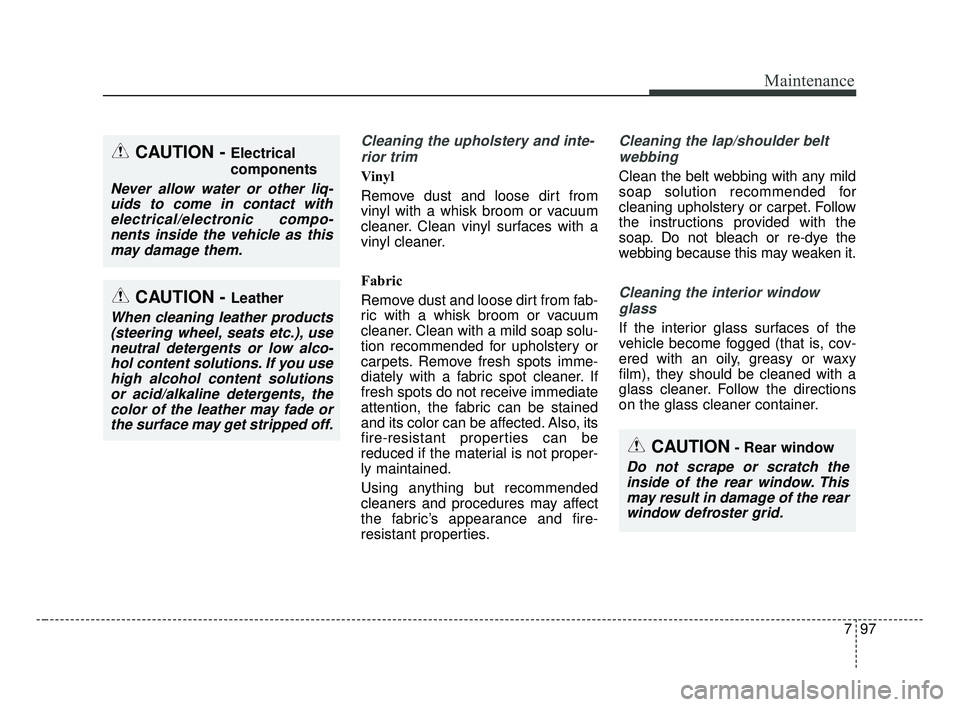
797
Maintenance
Cleaning the upholstery and inte-rior trim
Vinyl
Remove dust and loose dirt from
vinyl with a whisk broom or vacuum
cleaner. Clean vinyl surfaces with a
vinyl cleaner.
Fabric
Remove dust and loose dirt from fab-
ric with a whisk broom or vacuum
cleaner. Clean with a mild soap solu-
tion recommended for upholstery or
carpets. Remove fresh spots imme-
diately with a fabric spot cleaner. If
fresh spots do not receive immediate
attention, the fabric can be stained
and its color can be affected. Also, its
fire-resistant properties can be
reduced if the material is not proper-
ly maintained.
Using anything but recommended
cleaners and procedures may affect
the fabric’s appearance and fire-
resistant properties.
Cleaning the lap/shoulder beltwebbing
Clean the belt webbing with any mild
soap solution recommended for
cleaning upholstery or carpet. Follow
the instructions provided with the
soap. Do not bleach or re-dye the
webbing because this may weaken it.
Cleaning the interior windowglass
If the interior glass surfaces of the
vehicle become fogged (that is, cov-
ered with an oily, greasy or waxy
film), they should be cleaned with a
glass cleaner. Follow the directions
on the glass cleaner container.
CAUTION- Rear window
Do not scrape or scratch theinside of the rear window. Thismay result in damage of the rearwindow defroster grid.
CAUTION - Electrical
components
Never allow water or other liq-uids to come in contact withelectrical/electronic compo-nents inside the vehicle as thismay damage them.
CAUTION - Leather
When cleaning leather products(steering wheel, seats etc.), useneutral detergents or low alco-hol content solutions. If you usehigh alcohol content solutionsor acid/alkaline detergents, thecolor of the leather may fade orthe surface may get stripped off.
BDm CAN (ENG) 7.qxp 7/4/2018 10:27 AM Page 97
Page 526 of 550
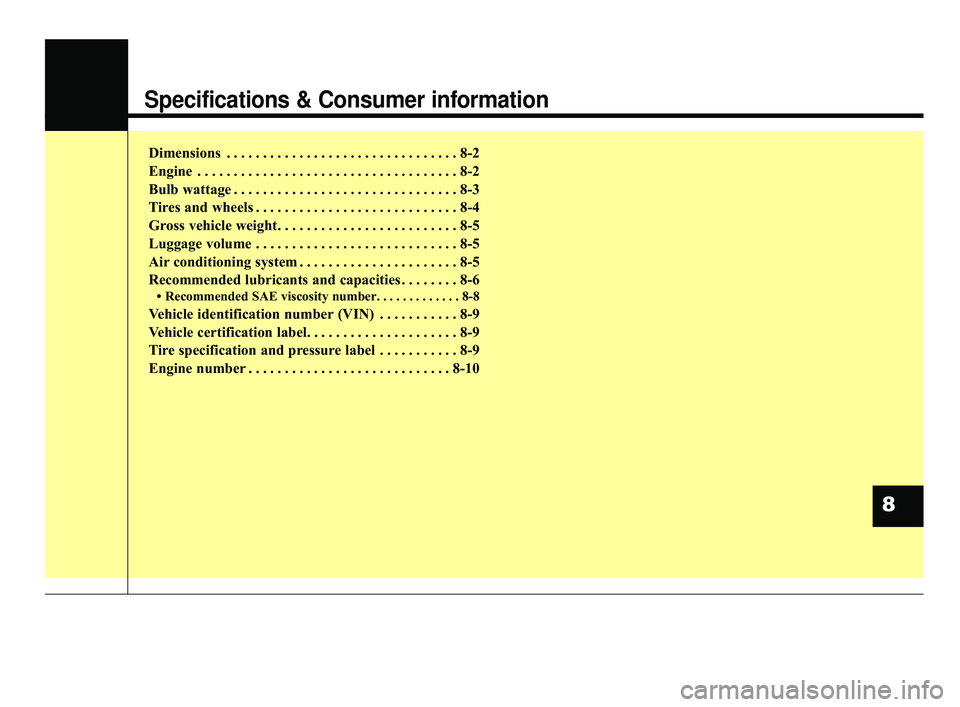
Specifications & Consumer information
Dimensions . . . . . . . . . . . . . . . . . . . . . . . . . . . . . . . . 8-2
Engine . . . . . . . . . . . . . . . . . . . . . . . . . . . . . . . . . . . . \
8-2
Bulb wattage . . . . . . . . . . . . . . . . . . . . . . . . . . . . . . . 8-3
Tires and wheels . . . . . . . . . . . . . . . . . . . . . . . . . . . . 8-4
Gross vehicle weight. . . . . . . . . . . . . . . . . . . . . . . . . 8-5
Luggage volume . . . . . . . . . . . . . . . . . . . . . . . . . . . . 8-5
Air conditioning system . . . . . . . . . . . . . . . . . . . . . . 8-5
Recommended lubricants and capacities . . . . . . . . 8-6
• Recommended SAE viscosity number. . . . . . . . . . . . . 8-8
Vehicle identification number (VIN) . . . . . . . . . . . 8-9
Vehicle certification label. . . . . . . . . . . . . . . . . . . . . 8-9
Tire specification and pressure label . . . . . . . . . . . 8-9
Engine number . . . . . . . . . . . . . . . . . . . . . . . . . . . . 8-10
8
BDm CAN (ENG) 8.qxp 7/4/2018 5:40 PM Page 1
Page 527 of 550

Specifications, Consumer information, Reporting safety defects
28
DIMENSIONS
ENGINE
Itemmm (in)
Overall length 4,640 (182.7)
Overall width 1,800 (70.9)
Overall height1,435 (56.5)
Front tread
195/65R15 1,563 (61.5)
205/55R161,555 (61.2)
225/45R171,549 (61.0)
Rear tread
195/65R15 1,572 (61.9)
205/55R161,564 (61.6)
225/45R171,558 (61.3)
Wheelbase 2,700 (106.3)
ItemGasoline 2.0
Displacement cc (cu.in)1,999
(121.9)
Bore x Stroke mm (in.)81 x 97
(3.19 x 3.82)
Firing order 1-3-4-2
No. of cylinders 4, In-line
BDm CAN (ENG) 8.qxp 7/4/2018 5:40 PM Page 2
Page 529 of 550
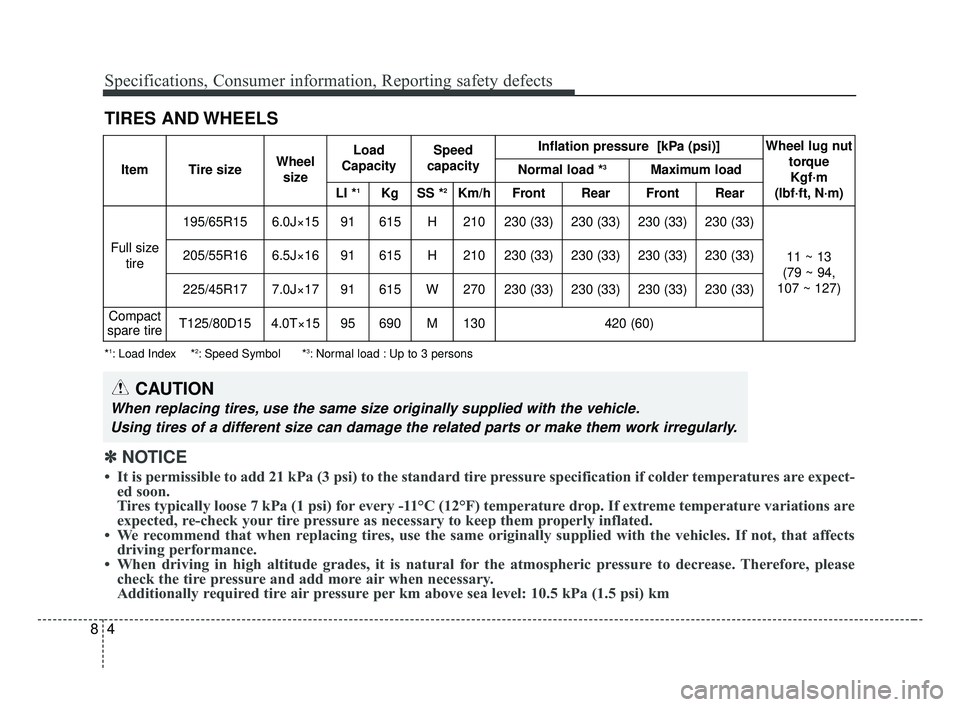
Specifications, Consumer information, Reporting safety defects
48
TIRES AND WHEELS
*1: Load Index *2: Speed Symbol *3: Normal load : Up to 3 persons
CAUTION
When replacing tires, use the same size originally supplied with the vehicle.Using tires of a different size can damage the related parts or make them work irregularly.
✽ ✽ NOTICE
• It is permissible to add 21 kPa (3 psi) to the standard tire pressure specification if colder temperatures are expect-
ed soon.
Tires typically loose 7 kPa (1 psi) for every -11°C (12°F) temperature drop. If extreme temperature variations are
expected, re-check your tire pressure as necessary to keep them properly inflated.
• We recommend that when replacing tires, use the same originally supplied with the vehicles. If not, that aff\
ects driving performance.
• When driving in high altitude grades, it is natural for the atmospheric pressure to decrease. Therefore, please check the tire pressure and add more air when necessary.
Additionally required tire air pressure per km above sea level: 10.5 kPa (1.5 psi) km
ItemTire sizeWheel
sizeLoad
CapacitySpeed
capacityInflation pressure [kPa (psi)]Wheel lug nut torque Kgf·m
(lbf·ft, N·m)
Normal load *3Maximum load
LI *1KgSS *2Km/hFront RearFront Rear
Full size tire
195/65R156.0J×1591615H210230 (33)230 (33)230 (33)230 (33)
11 ~ 13
(79 ~ 94,
107 ~ 127)205/55R166.5J×1691615H210230 (33)230 (33)230 (33)230 (33)
225/45R177.0J×1791615W270230 (33)230 (33)230 (33)230 (33)
Compact
spare tireT125/80D154.0T×1595690M130420 (60)
BDm CAN (ENG) 8.qxp 7/4/2018 5:40 PM Page 4
Page 542 of 550

I7
Index
Hazard warning flasher. . . . . . . . . . . . . . . . . . . . . . . . . . 6-2
Hazardous driving conditions . . . . . . . . . . . . . . . . . . . 5-128
Headlamp (High beam) bulb replacement (Headlamp Type A,B) . . . . . . . . . . . . . . . . . . . . . . . 7-77
Headlamp (LED type) replacement (Headlamp Type C) . . . . . . . . . . . . . . . . . . . . . . . . . 7-79
Headlamp (Low beam) bulb replacement (Headlamp Type A,B) . . . . . . . . . . . . . . . . . . . . . . . 7-75
Headlight (Headlamp) escort function . . . . . . . . . . . . 4-113
Headlight position. . . . . . . . . . . . . . . . . . . . . . . . . . . . 4-101
Headrest (rear) . . . . . . . . . . . . . . . . . . . . . . . . . . . . . . . 3-13
Headrest (front). . . . . . . . . . . . . . . . . . . . . . . . . . . . . . . 3-10
Heated steering wheel. . . . . . . . . . . . . . . . . . . . . . . . . . 4-49
High - beam operation . . . . . . . . . . . . . . . . . . . . . . . . 4-102
High Beam Assist . . . . . . . . . . . . . . . . . . . . . . . . . . . . 4-103
High mounted stop lamp (bulb type) bulb replacement . . . . . . . . . . . . . . . . . . . . . . . . . . . . . . . 7-85
High mounted stop lamp (LED type) bulb replacement . . . . . . . . . . . . . . . . . . . . . . . . . . . . . . . 7-84
Highway driving . . . . . . . . . . . . . . . . . . . . . . . . . . . . . 5-131
Hill-start Assist Control (HAC) . . . . . . . . . . . . . . . . . . 5-44
Hood . . . . . . . . . . . . . . . . . . . . . . . . . . . . . . . . . . . . \
. . . 4-35
Horn . . . . . . . . . . . . . . . . . . . . . . . . . . . . . . . . . . . . \
. . . 4-49
How vehicle audio works . . . . . . . . . . . . . . . . . . . . . . 4-156 Immobilizer system . . . . . . . . . . . . . . . . . . . . . . . . . . . 4-13
Indicator lights . . . . . . . . . . . . . . . . . . . . . . . . . . . . . . . 4-90
Inflation conditions (Air bags) . . . . . . . . . . . . . . . . . . . 3-64
Inside rearview mirror . . . . . . . . . . . . . . . . . . . . . . . . . 4-51
Installing a Child Restraint System (CRS). . . . . . . . . . 3-36
Instrument cluster . . . . . . . . . . . . . . . . . . . . . . . . . . . . . 4-56
Distance to empty. . . . . . . . . . . . . . . . . . . . . . . . . . . 4-63
Gauges . . . . . . . . . . . . . . . . . . . . . . . . . . . . . . . . . . . 4-\
58
Indicator lights . . . . . . . . . . . . . . . . . . . . . . . . . . . . . 4-90
LCD modes . . . . . . . . . . . . . . . . . . . . . . . . . . . . . . . 4-69
LCD window control . . . . . . . . . . . . . . . . . . . . . . . . 4-57
LCD windows . . . . . . . . . . . . . . . . . . . . . . . . . . . . . 4-63
Service Mode . . . . . . . . . . . . . . . . . . . . . . . . . . . . . . 4-70
Trip computer . . . . . . . . . . . . . . . . . . . . . . . . . . . . . . 4-63
Trip modes . . . . . . . . . . . . . . . . . . . . . . . . . . . . . . . . 4-64
User settings mode . . . . . . . . . . . . . . . . . . . . . . . . . . 4-71
Warning and Indicator lights . . . . . . . . . . . . . . . . . . 4-80
Warning lights . . . . . . . . . . . . . . . . . . . . . . . . . . . . . 4-80
Intelligent Variable Transmission (IVT) . . . . . . . . . . . . 5-22 Good driving practices . . . . . . . . . . . . . . . . . . . . . . . 5-28
Intelligent Variable Transmission (IVT) operation . 5-22
Interior care. . . . . . . . . . . . . . . . . . . . . . . . . . . . . . . . . . 7-96\
Interior features. . . . . . . . . . . . . . . . . . . . . . . . . . . . . . 4-144 Air ventilation seat . . . . . . . . . . . . . . . . . . . . . . . . . 4-146
Clothes hanger . . . . . . . . . . . . . . . . . . . . . . . . . . . . 4-153
Cup holder . . . . . . . . . . . . . . . . . . . . . . . . . . . . . . . 4-144
HI
BDm CAN (ENG) Index.qxp 6/30/2018 2:03 PM Page 7